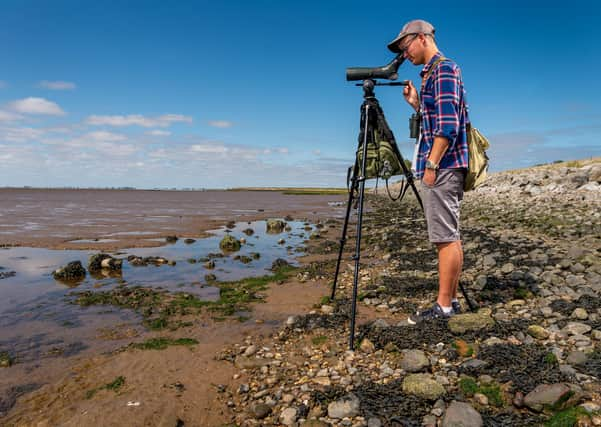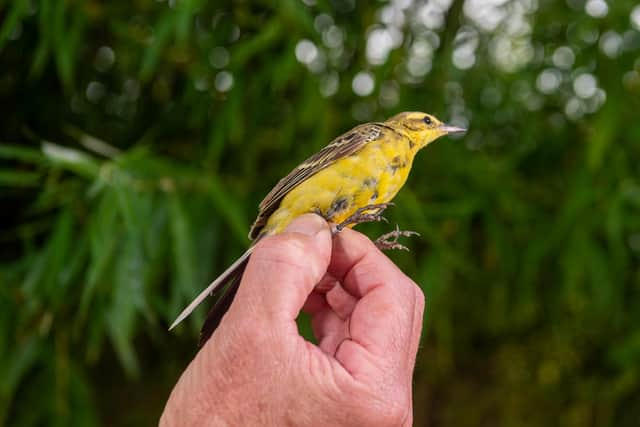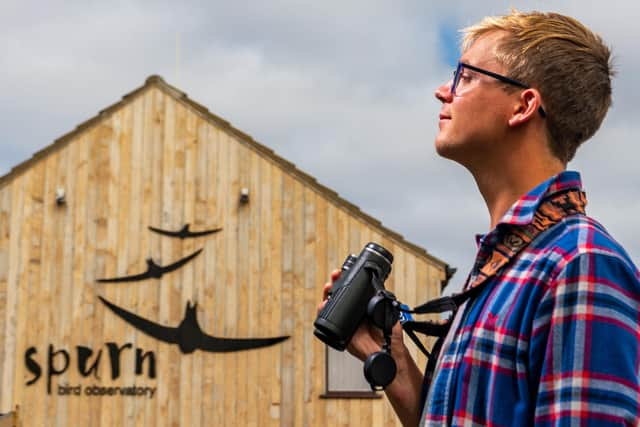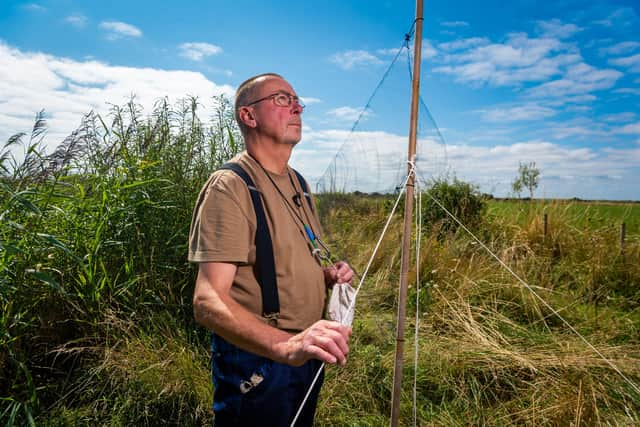Why birdwatchers will be flocking to Spurn Point in Yorkshire at the weekend


Birders will flock to the remotest tip of the Holderness peninsula next weekend in the hope of catching a glimpse of a migrating species. Bird migration is one of the wonders of the natural world and the Migration Festival at Spurn Point will see crowds of binocular-wielding visitors hoping to spot grounded migrants, seabirds and estuary birds that have flown thousands of miles to the UK en route to warmer climes.
Rob Adams, who as chairman of the Spurn Observatory will attempt to corral the enthusiasts, has seen the phenomenon many times before. He was around 10 when he started to develop an interest in the birds in his garden, and went on to learn about the science of ringing – putting a ring on a bird’s leg so that its progress can be tracked around the world.
Advertisement
Hide AdAdvertisement
Hide Ad“It’s all about the survival of the species,” he says. “As birds are migrating down the coast, they come to Spurn Head. As a narrow peninsula, it acts as a bottleneck, and the birds follow the funnel all the way down, then leave the end of the peninsula on their journey south to their wintering quarters. The peninsula concentrates the birds and makes them accessible and easier to count.”


There are more than 10,000 species of bird in the world, a significant amount of which are migratory. With their songs, plumage, colours and antics, they invite us to learn about them and the ecosystems they inhabit.
The observatory at Kilnsea, about two miles from the tidal island of Spurn itself, has provided accommodation for nearly 75 years for thousands of people who enjoy watching birds and other wildlife. The festival was first held in 2013 and is now staged jointly by the Spurn Bird Observatory Trust and the British Trust for Ornithology. Guest speaker this year is Killian Mullarney, an Irish ornithologist and bird artist. An accomplished artist, he has illustrated large sections of the Collins Bird Guide – “the birder’s bible”.
Observatory estate worker Jonnie Fisk first visited the observatory in his teens, and immediately felt a connection to the community of birders and migration-watchers on the wild, muddy stretch of North Sea coast. “As youngsters, my friend and I were encouraged and mentored here on weekend visits, seeing some amazing birds and scenes of migration in the process.” Now employed full time, Jonnie adds: “I really can’t think of anything else I’d rather do or anywhere else I’d rather be.”
Advertisement
Hide AdAdvertisement
Hide AdVolunteer Bethan Clyne got involved as she wanted to help with the habitat management while assisting with the recording of the bird and animal migration. “Spurn is brilliant due to its geography; the Humber and sea meeting – creating a fantastic peninsula funneling migratory birds. This means there can be days of immense passage of birds, where thousands are either heading south overland, or hopping about bush to bush feeding after their tiresome sea crossing, or even large passages of seabirds out at sea like sooty shearwaters on their around-the-world migration.”


Today, all you need to go birding is a pair of binoculars, a camera and your phone. “Fifty years ago, if you didn’t know what the bird was, you’d go back home and look it up in a reference book,” says Rob. “When I first started off I had a basic camera, a Zenith. You’d get the pictures probably several weeks after you first took the shot because you’d need to use the film up, then send it off to be developed, by which time the bird has probably migrated 2,000 miles.”
For birders like Rob, the best sightings come at this time of year with the autumn fall of migrant birds. ”The weather can turn quickly. The birds are busy migrating and they set off in fair weather, then they come across a weather front of rain, cloud, sometimes strong wind, so they have to seek shelter, although the impulse is to keep migrating.
“They ditch down, seek shelter and find whatever food there is. They encounter some inclement weather and we get a huge arrival of birds on the east coast. You see them all along the peninsula, the bushes are alive, the ground is alive, they are driven to keep migrating to their wintering quarters and the minute the weather improves, they’re gone. A day later, it looks like there has never been a bird there. It just shows you the power and impulse that is built into these birds that just make them do what they do. Autumn falls of migrant birds are the icing on the cake for me.”
Advertisement
Hide AdAdvertisement
Hide AdRob has travelled thousands of miles to go birding in places like India, Thailand, Africa, South East Asia and Scandinavia, but his main interest is migration. “This is what Spurn is about and it always fascinates me. You think of the tiny little goldcrest, which weighs about five-and-a-half grammes; it leaves Scandinavia and it flies for – who knows – 15, 20 hours across the North Sea and it arrives in the UK on the east coast. It weighs less than a 10p piece, and it arrives in sometimes terrible weather conditions.”


There are 22 bird observatories in the UK, all in coastal locations, which record and ring birds for scientific studies. The peninsula is owned by the Yorkshire Wildlife Trust which bought it from the Ministry of Defence in 1959 after there was a large military presence during the First and Second World Wars.
A twitcher, says Rob, is someone who is notified of a rare bird arriving in Britain and will throw their equipment into the car and go and see it. Then the next day they might go off in a totally different direction to see another rare bird. “They call them ‘listers’ nowadays, people who try to get the longest list of species they can record in a single year in the UK. So they might have a UK list and a European list. I suppose it’s not too dissimilar to trainspotting.”
Such enthusiasts sometimes arrive en masse to see a rare bird – as in 2016, when a Siberian accentor arrived in the UK, and the first mainland recording was at Spurn. Around 3,000 birders descended on the peninsula and the observatory members organised a queuing system at the side of the Easington gas terminal, so that everyone could catch a glimpse of the bird, which had by then settled in the garden of a bungalow.
Advertisement
Hide AdAdvertisement
Hide AdInevitably, climate change has had an effect, with the birds arriving earlier in springtime, and with the migration period, which used to run from August to the end of October, now extending to the end of November. “It only has to be one degree, or one-and-a-half degrees, change and things are altered massively. In springtime, we get more of those cold northerly and easterly winds, followed by a warm and wet May and June. Birds start breeding in May and they think everything’s fine and then we get a wet June and it wipes out a lot of breeding birds.”
The pandemic also had an impact. “From a bird’s perspective, it was probably a benefit,” says Rob. “There were a lot fewer people out in the field, so the production rate from breeding due to lack of disturbance was much improved. The downside was that people didn’t get out, so fewer birds were found than in other years. We couldn’t open the observatory building and people couldn’t stay at Spurn, and we had to cancel our festival.”
This year’s festival weekend will feature bird identification walks, a bat walk and even a plant walk. There will be bird-ringing demonstrations, art classes and digiscoping classes. “We bottle up all our knowledge and experience of bird migration for the festival and share it. People just get smitten with it,” says Rob.
The Spurn Migration Festival runs from September 10-12. www.spurnmigfest.com; www.spurnbirdobservatory.co.uk
Comment Guidelines
National World encourages reader discussion on our stories. User feedback, insights and back-and-forth exchanges add a rich layer of context to reporting. Please review our Community Guidelines before commenting.